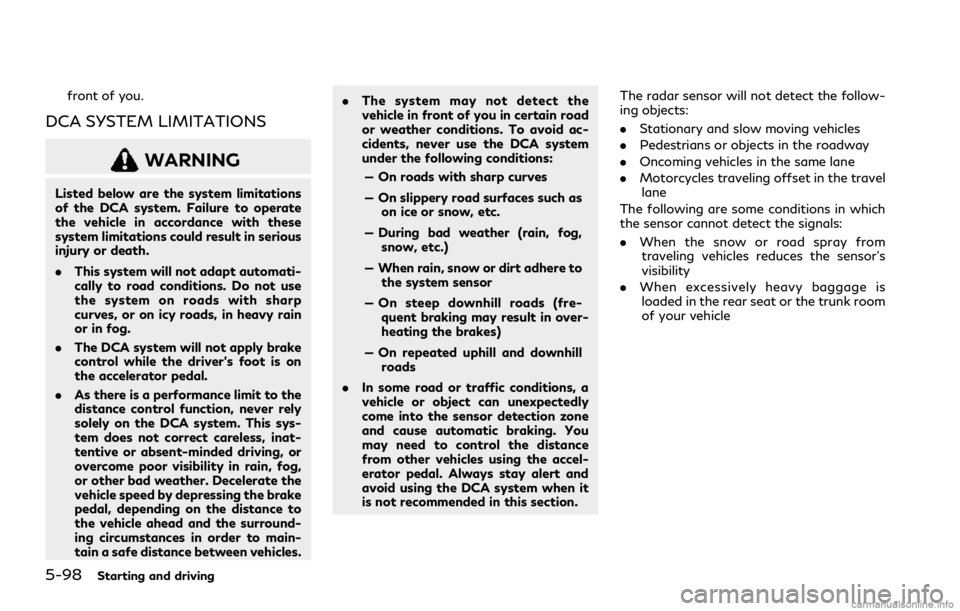warning INFINITI Q50 2021 Owner's Manual
[x] Cancel search | Manufacturer: INFINITI, Model Year: 2021, Model line: Q50, Model: INFINITI Q50 2021Pages: 484, PDF Size: 1.86 MB
Page 309 of 484

.When the INFINITI Drive Mode Selector
is turned to the SNOW mode
. When the radar signal is temporarily
interrupted
Action to take:
When the conditions listed above are no
longer present, turn the ICC system back on
to use the system.
JVS0221X
ICC system warning
Condition B:
Under the following conditions, making it
impossible to detect a vehicle ahead, the ICC
system is automatically canceled.
The chime will sound, the ICC system
warning (orange) and the “front radar ob-
struction” warning message will appear in
the vehicle information display.
. When the radar sensor area of the front
bumper is covered with dirt or is ob-
structed Action to take:
If the warning (orange) or warning message
appears, stop the vehicle in a safe place,
place the shift lever in the P (Park) position
and turn the engine off. When the radar
signal is temporarily interrupted, clean the
sensor area of the front bumper and restart
the engine. If the warning (orange) or
warning message continues to be displayed,
have the system checked. It is recommended
you visit an INFINITI retailer for this service.
.
When driving on roads with limited road
structures or buildings (for example, long
bridges, deserts, snow fields, driving next
to long walls)
Action to take:
When the above conditions no longer exist,
the ICC system will resume automatically.
Condition C:
When the ICC system is not operating
properly, the chime sounds and the ICC
system warning (orange) will appear.
Action to take:
If the warning appears, stop the vehicle in a
safe place and place the shift lever in the P
(Park) position. Turn the engine off, restart
the engine, resume driving and set the ICC
system again.
If it is not possible to set the system or the
warning stays on, it may indicate that the
Starting and driving5-85
Page 310 of 484

5-86Starting and driving
ICC system is malfunctioning. Although the
vehicle is still driveable under normal con-
ditions, have the vehicle checked. It is
recommended you visit an INFINITI retailer
for this service.
JVS1123X
System maintenance
The sensor for the ICC systemis located
behind the lower grille of the front bumper.
To keep the ICC system operating properly,
be sure to observe the following:
. Always keep the sensor area of the front
bumper clean.
. Do not strike or damage the areas around
the sensor.
. Do not cover or attach stickers or similar
objects on the front bumper near the
sensor area. This could cause failure or
malfunction.
. Do not attach metallic objects near the
sensor area (brush guard, etc.). This could cause failure or malfunction.
. Do not alter, remove or paint the front
bumper. It is recommended you contact
an INFINITI retailer before customizing
or restoring the front bumper.
FCC Notice:
For USA:
This device complies with Part 15 of the
FCC Rules. Operation is subject to the
following two conditions:
1. This device may not cause harmful
interference, and
2. This device must accept any interfer-
ence received, including interference
that may cause undesired operation.
FCC Warning
Changes or modification not expressly ap-
proved by the party responsible for com-
pliance could void the user’s authority to
operate the equipment.
For Canada:
This device complies with Industry Canada
licence-exempt RSS standard(s). Operation
is subject to the following two conditions:
1. This device may not cause interference,
and
2. This device must accept any interfer-
ence, including interference that may
cause undesired operation of the device.
Page 311 of 484

CONVENTIONAL (fixed speed)
CRUISE CONTROL MODE
This mode allows driving at a speed between
25 to 90 MPH (40 to 144 km/h) without
keeping your foot on the accelerator pedal.
WARNING
.In the conventional (fixed speed)
cruise control mode, a warning chime
does not sound to warn you if you are
too close to the vehicle ahead, as
neither the presence of the vehicle
ahead nor the vehicle-to-vehicle dis-
tance is detected.
. Pay special attention to the distance
between your vehicle and the vehicle
ahead of you or a collision could
occur.
. Always confirm the setting in the ICC
system display.
. Do not use the conventional (fixed
speed) cruise control mode when
driving under the following condi-
tions:
— when it is not possible to keep the vehicle at a set speed
— in heavy traffic or in traffic that varies in speed — on winding or hilly roads
— on slippery roads (rain, snow, ice,
etc.)
— in very windy areas
. Doing so could cause a loss of vehicle
control and result in an accident.
JVS0841X
Conventional (fixed speed) cruise
control switches
1. RESUME/ACCELERATE (+) switch:
Resumes set speed or increases speed
incrementally.
2. SET/COAST (-) switch: Sets the desired cruise speed, reduces
speed incrementally.
3. CANCEL switch: Deactivates the system without erasing
the set speed.
4. MAIN switch: Master switch to activate the system.
Starting and driving5-87
Page 312 of 484

5-88Starting and driving
JVS0301X
Conventional (fixed speed) cruise
control mode display and indicators
The display is located in the vehicle informa-
tion display.
1. Cruise indicator:This indicator indicates the condition of
ICC system depending on a color.
.Cruise control ON indicator (white):Indicates that the MAIN switch is ON.
.Cruise control set indicator (green):Displays while the vehicle speed is
controlled by the conventional (fixed
speed) cruise control mode of the ICC
system.
.Cruise control system warning (or-ange):
Indicates that there is a malfunction in
the ICC system.
2. Set vehicle speed indicator: This indicator indicates the set vehicle
speed.
For Canadian models, the speed is dis-
played in km/h.
JVS0842X
Operating conventional (fixed
speed) cruise control mode
To turn on the conventional (fixed speed)
cruise control mode, push and hold the
MAIN switch
for longer than about 1.5
seconds.
When pushing the MAIN switch on, the
conventional (fixed speed) cruise control
mode display and indicators are displayed
in the vehicle information display. After you
hold the MAIN switch on for longer than
about 1.5 seconds, the ICC system display
turns off. The cruise indicator appears. You
can now set your desired cruising speed.
Pushing the MAIN switch again will turn the
Page 314 of 484

5-90Starting and driving
3. Push, then quickly release the SET/COAST (-) switch. Each time you do this,
the set speed will decrease by about 1
MPH (1.6 km/h).
To resume the preset speed, push and
release the RESUME/ACCELERATE (+)
switch. The vehicle will resume the last set
cruising speed when the vehicle speed is over
25 MPH (40 km/h).
System temporarily unavailable
A chime sounds under the following condi-
tions and the control is automatically can-
celed.
. When the vehicle slows down more than
8 MPH (13 km/h) below the set speed
. When the shift lever is not in the D (Drive)
or manual shift mode
. When the parking brake is applied.
. When the VDC operates (including the
traction control system)
. When a wheel slips
JVS0306X
Warning
When the system is not operating properly,
the chime sounds and the color of the cruise
indicator will change to orange.
Action to take:
If the color of the cruise indicator changes to
orange, stop the vehicle in a safe place and
place the shift lever in the P (Park) position.
Turn the engine off, restart the engine,
resume driving and then perform the setting
again.
If it is not possible to set or the indicator
stays on, it may indicate that the system is
malfunctioning. Although the vehicle is still
driveable under normal conditions, have the vehicle checked. It is recommended you visit
an INFINITI retailer for this service.
Page 315 of 484

WARNING
Failure to follow the warnings and
instructions for proper use of the DCA
system could result in serious personal
injury or death.
.Always drive carefully and atten-
tively when using the DCA system.
Read and understand the Owner’s
Manual thoroughly before using the
DCA system. To avoid serious injury
or death, do not rely on the system to
prevent accidents or to control the
vehicle’s speed in emergency situa-
tions. Do not use the DCA system
except in appropriate road and traffic
conditions.
. This system is only an aid to assist the
driver and is not a collision warning or
avoidance device. It is the driver’s
responsibility to stay alert, drive
safely and be in control of the vehicle
at all times.
. As there is a performance limit to the
distance control function, never rely
solely on the DCA system. This sys-
tem does not correct careless, inat-
tentive or absent-minded driving, or
overcome poor visibility in rain, fog,
or other bad weather. Decelerate the vehicle speed by depressing the brake
pedal, depending on the distance to
the vehicle ahead and the surround-
ing circumstances in order to main-
tain a safe distance between vehicles.
. Always pay attention to the opera-
tion of the vehicle and be ready to
manually decelerate to maintain the
proper following distance. The DCA
system may not be able to decelerate
the vehicle under some circum-
stances.
. This system only brakes and moves
the accelerator pedal upward to help
assist the driver to maintain a follow-
ing distance from the vehicle ahead.
Acceleration should be operated by
the driver.
. The DCA system does not control
vehicle speed or warn you when you
approach stationary and slow moving
vehicles. You must pay attention to
vehicle operation to maintain proper
distance from vehicles ahead.
. The DCA system automatically de-
celerates your vehicle to help assist
the driver to maintain a following
distance from the vehicle ahead.
Manually brake when deceleration is
required to maintain a safe distance
upon sudden braking by the vehicle ahead or when a vehicle suddenly
appears in front of you. Always stay
alert when using the DCA system.
. If the vehicle ahead comes to a stop,
the vehicle decelerates to a standstill
within the limitations of the system.
The system will cancel with a warning
chime once it judges that the vehicle
has come to a standstill. To prevent
the vehicle from moving, the driver
must depress the brake pedal.
Starting and driving5-91
DISTANCE CONTROL ASSIST
(DCA) (if so equipped)
Page 317 of 484

DCA SYSTEM OPERATION
WARNING
Failure to follow the warnings and
instructions for proper use of the DCA
system could result in serious personal
injury or death.
.When the vehicle ahead detection
indicator is not illuminated, system
will not control the vehicle or warn
the driver.
. Never place your foot under the
brake pedal. Your foot may be caught
when the system controls the brake.
. Depending on the position of the
accelerator pedal, the system may
not be able to assist the driver to
release the accelerator pedal appro-
priately.
The DCA system brakes and moves the
accelerator pedal upward according to the
distance from and the relative speed of the
vehicle ahead to help assist the driver in
maintaining a following distance. The sys-
tem will decelerate as necessary and if the
vehicle ahead comes to a stop, the vehicle
decelerates to a standstill. However, the
DCA system can only apply up to approxi- mately 40% of the vehicle’s total braking
power. If a vehicle moves into the traveling
lane ahead or if a vehicle traveling ahead
rapidly decelerates, the distance between
vehicles may become closer because the
DCA system cannot decelerate the vehicle
quickly enough. If this occurs, the DCA
system will sound a warning chime and blink
the system display to notify the driver to
take necessary action.
See “Approach warning” (P.5-95).
Starting and driving5-93
Page 318 of 484

5-94Starting and driving
JVS0244X
System set display with a vehicle ahead
System set display without a vehicle
ahead
System set display with a vehicle ahead
(brake operation is necessary)
The DCA system helps assist the driver to
keep a following distance to the vehicle
ahead by braking and moving the accelera-
tor pedal upward in the normal driving
condition.
When a vehicle ahead is detected:
The vehicle ahead detection indicator ap-
pears. When the vehicle approaches a vehicle
ahead:
.
If the driver’s foot is not on the accel-
erator pedal, the system activates the
brakes to decelerate smoothly as neces-
sary. If the vehicle ahead comes to a
stop, the vehicle decelerates to a stand-
still within the limitations of the system.
. If the driver’s foot is on the accelerator
pedal, the system moves the accelerator
pedal upward to assist the driver to
release the accelerator pedal.
When brake operation by the driver is
required:
The system alerts the driver by a warning
chime and blinking the vehicle ahead detec- tion indicator. If the driver’s foot is on the
accelerator pedal after the warning, the
system moves the accelerator pedal upward
to assist the driver to switch to the brake
pedal.
NOTE:
.
The stop lights of the vehicle come on
when braking is performed by the DCA
system.
. When the brake operates, a noise may be
heard. This is not a malfunction.
Overriding the system:
The following driver’s operation overrides
the system operation.
. When the driver depresses the accelera-
tor pedal even further while the system is
moving the accelerator pedal upward,
the DCA system control of the accel-
erator pedal is canceled.
. When the driver’s foot is on the accel-
erator pedal, the brake control by the
system is not operated.
. When the driver’s foot is on the brake
pedal, neither the brake control nor the
alert by the system operates.
. When the Intelligent Cruise Control (ICC)
system is set, the DCA system will be
inactive.
Page 319 of 484

Approach warning
If your vehicle comes closer to the vehicle
ahead due to rapid deceleration of that
vehicle or if another vehicle cuts in, the
system warns the driver with the chime and
DCA system display. Decelerate by depres-
sing the brake pedal to maintain a safe
vehicle distance if:
.The chime sounds.
. The vehicle ahead detection indicator
blinks.
. The driver assist system forward indica-
tor (orange) blinks.
The warning chime may not sound in some
cases when there is a short distance be-
tween vehicles. Some examples are:
. When the vehicles are traveling at the
same speed and the distance between
vehicles is not changing
. When the vehicle ahead is traveling
faster and the distance between vehicles
is increasing
. When a vehicle cuts in near your vehicle
The driver assist system forward indicator
(orange) blinks and the warning chime will
not sound when your vehicle approaches
vehicles that are parked or moving slowly. NOTE:
The approach warning chime may sound
and the driver assist system forward in-
dicator (orange) may blink when the radar
sensor detects objects on the side of the
vehicle or on the side of the road. This may
cause the DCA system to decelerate or
accelerate the vehicle. The radar sensor
may detect these objects when the vehicle
is driven on winding roads, narrow roads,
hilly roads or when entering or exiting a
curve. In these cases you will have to
manually control the proper distance ahead
of your vehicle.
Also, the sensor sensitivity can be affected
by vehicle operation (steering maneuver or
driving position in the lane) or traffic or
vehicle condition (for example, if a vehicle is
being driven with some damage).
Starting and driving5-95
Page 322 of 484

5-98Starting and driving
front of you.
DCA SYSTEM LIMITATIONS
WARNING
Listed below are the system limitations
of the DCA system. Failure to operate
the vehicle in accordance with these
system limitations could result in serious
injury or death.
.This system will not adapt automati-
cally to road conditions. Do not use
the system on roads with sharp
curves, or on icy roads, in heavy rain
or in fog.
. The DCA system will not apply brake
control while the driver’s foot is on
the accelerator pedal.
. As there is a performance limit to the
distance control function, never rely
solely on the DCA system. This sys-
tem does not correct careless, inat-
tentive or absent-minded driving, or
overcome poor visibility in rain, fog,
or other bad weather. Decelerate the
vehicle speed by depressing the brake
pedal, depending on the distance to
the vehicle ahead and the surround-
ing circumstances in order to main-
tain a safe distance between vehicles. .
The system may not detect the
vehicle in front of you in certain road
or weather conditions. To avoid ac-
cidents, never use the DCA system
under the following conditions:
— On roads with sharp curves
— On slippery road surfaces such as on ice or snow, etc.
— During bad weather (rain, fog, snow, etc.)
— When rain, snow or dirt adhere to the system sensor
— On steep downhill roads (fre- quent braking may result in over-
heating the brakes)
— On repeated uphill and downhill roads
. In some road or traffic conditions, a
vehicle or object can unexpectedly
come into the sensor detection zone
and cause automatic braking. You
may need to control the distance
from other vehicles using the accel-
erator pedal. Always stay alert and
avoid using the DCA system when it
is not recommended in this section. The radar sensor will not detect the follow-
ing objects:
.
Stationary and slow moving vehicles
. Pedestrians or objects in the roadway
. Oncoming vehicles in the same lane
. Motorcycles traveling offset in the travel
lane
The following are some conditions in which
the sensor cannot detect the signals:
. When the snow or road spray from
traveling vehicles reduces the sensor’s
visibility
. When excessively heavy baggage is
loaded in the rear seat or the trunk room
of your vehicle